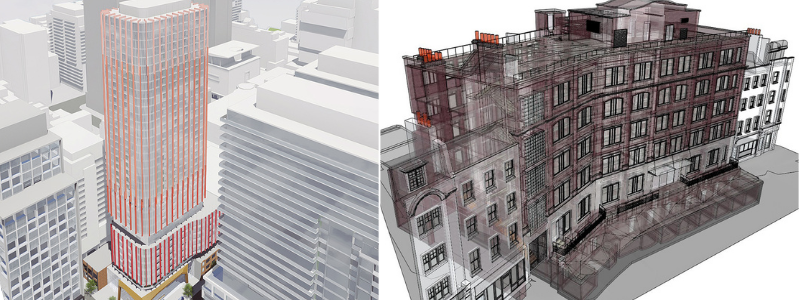Building information modeling services (BIM) is an intelligent form of 3D modeling, which enables a complete set of construction documentation, coordination, and simulation through the structure’s whole lifecycle from planning, designing, operation, maintenance, and demolition.
On the surface, a BIM file may look like a typical 3D asset because both are digital representations of the physical characteristics of an actual object. The model gives accurately detailed visualizations so that all professionals involved can explore design options and simulate multiple scenarios to see if (or how) they will alter the appearance and performance of the structure itself.
The BIM file contains every single bit of data necessary to give architects, engineers, and construction (AEC) professionals a deeper insight into the more efficient infrastructure management. The data stored in a BIM file can be extracted and exchanged to allow a much more educated decision-making process that affects how a structure will be built and managed. Think of it as the more intense data-driven version of the 3D model and rendering. Every parameter should deliver design coordination and construction improvements through better quality assurance and cost-efficiency.
RELATED: Differences Between 3D Modeling, CAD, and BIM Explained

BIM Basics
There seems to be some confusion over whether 3D models from CAD software are considered BIM files. That’s somewhat the case because the software also uses data to create an object, such as mathematical formulas. 3D CAD is much more versatile since designers use it in various industries, including product design, packaging, construction, games, movies, etc.
BIM exists explicitly for construction. Some suggest that BIM – especially from the construction industry’s point of view – is the logical evolution from 3D CAD. It takes advantage of a much larger set of data to create a comprehensive compilation of information in interactive 3D models.
Different design elements have their data, which combine into a single coordinated model by CAD services experts. Architects, engineers, and contractors can see how their inputs fit into the overall project. Moreover, the data includes the physical characteristics of design elements, their behaviors, and their relationship with the other aspects. The main goals of BIM are to achieve better cost predictability, more streamlined scheduling, design optimization, and fewer errors.
Information contained in a BIM object
There can be a limitless amount of data compiled into a single BIM object as it may contain whatever information the construction professionals put into the model. Data is updated in real-time, meaning changes are immediately visible on the screen, and BIM automatically calculates every bit of modification and uses new data instantly.
In addition to design parameters such as dimension, materials, colors, and textures, BIM can store data related to the functionality of the design element too. Even the estimated ongoing operational cost, including energy consumption, lighting, and structural integrity, is observable. When the construction project is on a large scale, such detailed information allows the building manager to plan the maintenance schedule accordingly.
RELATED: BIM Conversion Services: Hiring Engineers, Contractors, BIM Designers

BIM services
AEC professionals communicate with their drawings, but still now and then, they need to hire BIM Service to help streamline workflows and bring various aspects of the project into an integrated process where everyone can collaborate more efficiently. According to the 2020 NBS report, BIM adoption across industry professionals has significantly increased over the last decade. Awareness of the advantages of BIM now reached 73% just last year from only 57% in 2011.
The trend suggests that BIM is rapidly becoming the new standard in construction. Architectural firms offering BIM services can only increase the adoption rate in the coming years. Outsourcing the services also helps remove some persistent barriers, including the lack of skilled employees working on BIM software and the relatively significant investment in the software from the beginning.
Not all BIM services are equal, however. Although this is not a new thing, many architectural firms are still in the learning process. Many have not mastered it yet, so credentials, portfolio, and track records are more important than ever when hiring one. Here are some essential things you should know about working with BIM services.
Experience is invaluable
It is not uncommon for architectural firms to present themselves as leading BIM service providers. True experts in BIM are still relatively rare. That means that in-depth checks of their portfolio take a while. Always pay special attention to the scope of projects they have done previously. An experience in a project of bigger or the same scale as yours is a good point. They must substantiate all expert claims.
Please take a closer look at their past projects and case studies. If needs be, ask for a pilot project after outlining your expectations. This way, you have the chance to inspect the templates, standards, BIM objects, and all the other parameters in use. The firm will also demonstrate its communication practices and work methodologies during the process. The firm is a good fit if you align everything to industry standards.
Don’t be surprised if the firm asks for a much higher price than a 3D visualization service. BIM involves substantially more work, and the training alone can cost $2,000 on top of the monthly software subscription. In addition, more experienced BIM modeling experts and firms will increase the cost of your project.
Seeing is believing
In the next couple of years or so, BIM will be the mainstream in the construction industry. Looking for BIM services will be much easier, and the cost should be more competitive too. Until that day comes, choosing the exemplary BIM service for your drafting services project involves a thorough search, and justifiably so.
An architectural firm has an edge in BIM, thanks to the skills in its arsenal. It’s good to verify the firm’s credibility and employee credentials. Ask for an in-person meeting (or via video conference) and have a preliminary discussion on how the collaboration will theoretically work. Throw as many questions as you can at the representative regarding the firm’s history, technical expertise, and records of accomplishments. Once again, everything must be verifiable.
BIM deliverables
There are numerous formats for BIM files. Since you want to store info structured, you should generate deliverables in the formats supported by the central database that contains the overall project model. Some of the most common BIM deliverables are as follows:
- 2D CAD drafting
- 3D models
- 3D digital survey models
- BIM models maintenance
- 2D CAD drawing from a 3D BIM model
- 4D/5D modelling
- PDF plan drawings
- Schedules
- Room numbering diagrams
- Color-filled diagrams
- Employers Information Requirements (EIR)
- Project Information Requirements (PIR)
- Clash prevention
- Clash detection reports
- Visualizations: renders and animations
- Virtual tours: walkthroughs, flythrough models
- BIM Execution Plan (BEP)
- Digital Plan of Work
- Intelligent 3D libraries
- Asset performance optimization
- COBie (Construction Operations Building Information Exchange)
You create some deliverables at different stages of construction.
Reference matters
The point of checking a BIM service’s portfolio is to gather information on previous projects and cross-reference them with the clients listed. Both past and current clients make excellent sources of information to know more about how well the firm does its job in different project requirements. You can ask questions about the firm’s adherence to timeline and quality of deliverables too.
Testimonials and chatters in online forums may seem random, but they often provide helpful suggestions and tell you where to start digging for more.
Cheaper is not always better
It can be challenging to calculate the exact cost of BIM service when the project is still a work in progress. If something unexpected happens and the project requires a lot of changes, there will be more work than initially planned for the AEC professionals and the BIM service hired. The extent of all changes will affect how much it increases cost.
Even when the project goes exactly as expected without a single issue, BIM is not cheap. Do not get swayed by a firm that offers the lowest price for the best services. If something sounds too good to be true, it probably is. Bear in mind that low cost and less time is never a guarantee of efficient project execution.
They might also negatively affect the quality of deliverables. Even worse, low prices can indicate a lack of professional skills. On the other hand, a longer timeline and higher costs are not ideal either. You want a good balance between the amount of work required and the price involved.
RELATED: Industry Rates for BIM Services & Building Information Modeling Costs
Working with a freelancer
In the past, many considered freelancers as “second-class” professionals without a proper work environment and adequate equipment. Nowadays, freelancing is a lot more competitive than it used to be and filled with credentialed individuals offering their expertise for relatively affordable prices. Choosing a freelancer is just like looking for an architectural firm; you need to check their portfolios, verify past projects, and have a lengthy discussion about the project before hiring.
How Cad Crowd can Help
A good BIM service partner understands your expectations and demonstrates professionalism throughout the project. Here at Cad Crowd, we have the necessary skills to tackle any challenge. Get in touch with our friendly representative, and we’ll align an expert in the field to review your project. Get a quote today.
